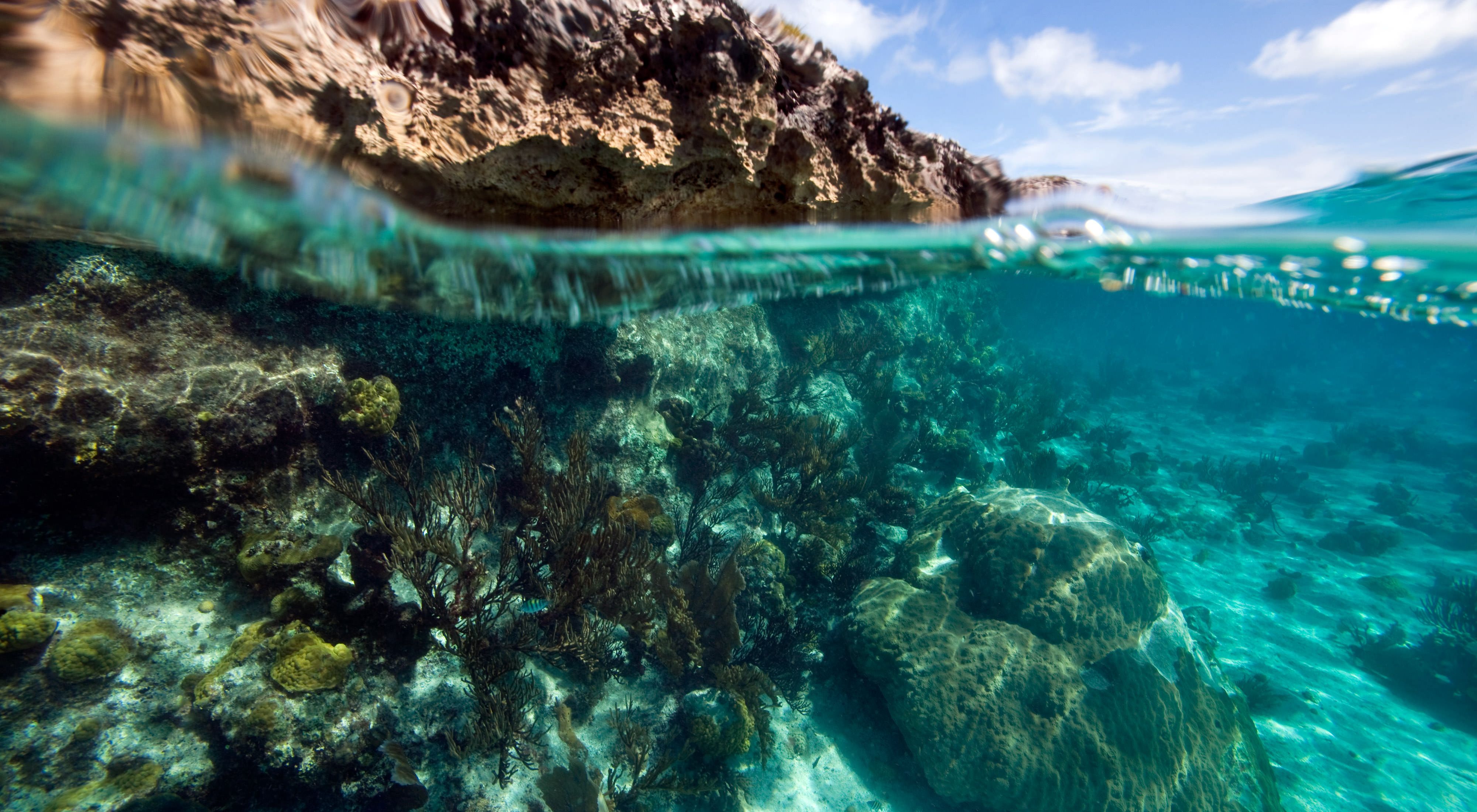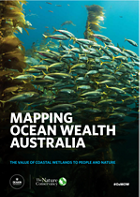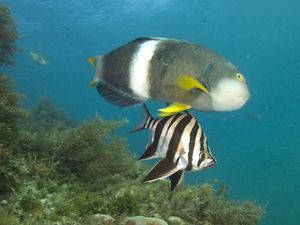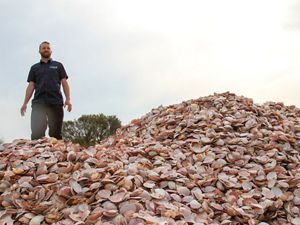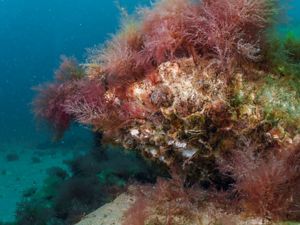Uncovering the value of Australia’s coastal wetlands
Making the case for protecting and restoring our coasts through mapping ocean wealth
Quote
~ 95% of all commercially important fish species depend on coastal habitats at some point during their lifecycle.
The importance of protection and restoration
Australia’s coastline is home to some of the most diverse underwater seascapes in the world. They benefit more than 19 million Australians — 80% of our total population. They provide fresh seafood, support recreational activities, remove pollution, protect shorelines and store carbon.
They suffer from over-exploitation and increasing development. Until now, very little information has been available to make the case for their protection or restoration. This is where understanding the benefits they provide can help.
Understanding the value of coastal wetlands as a social and economic benefit is key to appreciating their importance and enables coastal wetlands to be factored into decision making at all levels.
Coastal wetland types
- Saltmarsh
Saltmarshes are coastal wetlands that are flooded and drained, by salt-water, with the flood and ebb of the tide. Australia’s sub-tropical and temperate coastal saltmarshes are listed as vulnerable. This is a concern because they provide critical ecosystem services such as: filtering water, storing atmospheric carbon (blue carbon), nurseries for fish, and protecting and stabilising the coast. They’re also the base of the food chain for many marine and estuarine communities. - Mangroves
Many mangrove forests can be recognised by their tangle of roots that make the trees appear to be standing on stilts above the water. The root system is attractive to fish and other species seeking food and shelter from predators. Australia has the third largest area of mangroves globally. They’re recognised as one of the most productive habitats on Earth with most located in the tropical north. They can also be found in milder areas of Australia. Going as far south as Corner Inlet in Gippsland, Victoria. These mangroves are the most southerly in the world. - Seagrass beds
Seagrasses are a major feature of temperate coastlines in Australia. Australia is home to more than half the world’s 60 seagrass species. They provide essential ecosystem services as a nursery for young fish. Their dense roots stabilise soil and sediment which protects coasts from erosion and storms. They also serve as a nutrient sink and store atmospheric carbon.
Benefits of coastal wetlands
Coastal wetlands provide many ecosystem system services that benefit people and nature. They sustain commercial and recreational fisheries, protect our coastlines from ocean-related threats like storm surges and sea-level rise, sequester and store carbon, and provide a natural place for people to enjoy.

Powering Australia’s fisheries
About 95% of all commercially important fish species depend on coastal habitats at some point during their lifecycle. Without these important ecosystems, these popular species cannot get enough food to grow into adulthood. Understanding the benefits and value these habitats provide will help us strengthen and secure fish production, while improving marine conservation.
Value of coastal wetlands from fisheries:
- Contribute $35.5 million per year to nearshore commercial fisheries in south-eastern Australia via coastal wetlands..
- Provide 61% of the food that sustains and grows fish species targeted by commercial and recreational fishers such as: whiting, snapper, bream, and invertebrates such as prawns and crabs.
- Seagrasses in south-eastern Australia produce on average 207 kg more fish per hectare compared to areas without seagrass. We estimate 72,000 hectares of seagrass exists in south-eastern Australia — this equals an estimated average of 14 million tonnes more fish produced within seagrass areas each year.
The dependence of fisheries on these coastal wetlands means that loss or degradation of these ecosystems will also seriously impact coastal fisheries.

Recreational hotspots
Most of Australia’s population lives close to the coast. They're a wonderland for locals and visitors to enjoy, relax and unwind. We can make the case for investment to protect them by measuring the value of their benefits.
Value of coastal wetlands from tourism and recreation:
- Seagrasses are a haven for fish and the ideal spot for recreational fishing. Species of flathead, whiting and calamari squid can be found in abundance in and next to seagrass areas.
- Seagrass areas in Victoria’s two most popular coastal bays, Port Phillip and Western Port, provide a recreational benefit estimated at $36.5 million a year.
- Mangroves and saltmarshes attract birds and birdwatchers alike, with an estimated average value of $158 per trip.
Each summer, large flocks of migratory shorebirds land exhausted on the shores of Port Phillip and Western Port. Some species like the tiny Red-necked Stint or Critically Endangered Eastern Curlew travel from as far away as Siberia and Russia. Others, like the Critically Endangered Orange-bellied Parrot, migrate to Victoria’s coastal areas over winter from Tasmania.
What attracts them to Victoria’s coastline is the wealth of food found in saltmarshes, seagrass beds, mangroves and tidal mudflats. Migratory shorebirds feast for months to fatten up, so they can survive the long trip home and come back again the following year.

Most efficient way to store carbon
Coastal wetlands capture carbon dioxide from the air and store it in their leaves and wood. They also create the perfect environment for storing carbon captured within surrounding soil. This makes them among the most powerful carbon sinks on the planet.
Carbon storage capacity of coastal wetlands:
- In Victoria and New South Wales (NSW), coastal wetlands store 36,000 tonnes of CO2 per year. It’s equivalent to taking 7,826 cars off our roads.
- Restored mangroves in the Richmond River, NSW for example, have captured an impressive 11.5 tonnes of CO2 from the atmosphere per hectare per year in their first 25 to 40 years.
- If coastal wetlands are naturally allowed to migrate with changing sea level, rather than being drained or trapped in by concrete sea walls or rubble - these ecosystems in Victoria could store 1.6 million tonnes of carbon by 2050 with a value of $65 million.
- The carbon already stored in coastal wetland soils can range from 40 to 600 tonnes per hectare. An estimated 26 million tonnes of carbon is stored in mangroves, saltmarshes and seagrasses across Victoria and NSW.
Studies have shown that coastal wetlands can store carbon up to 40 times faster than rainforests and can remain there for thousands of years. Restoring coastal wetlands is the reverse of digging up and burning fossil fuels like coal or oil, because healthy coastal wetlands take greenhouse gases out of the air and store them in the ground.

Coastal protection - first line of defence
Mangroves, saltmarsh and seagrasses have stood guard over Australia’s coastlines for millennia. Their root structures and physical presence hold shorelines in place reducing erosion and wave damage, helping to preserve valuable shoreline assets and infrastructure
Value from coastal protection:
- Their root structures and physical presence hold shorelines in place. They reduce erosion, wave damage and help preserve valuable shoreline assets and infrastructure.
- Reduce wave energy by 37 to 71%. Protecting property across south-eastern Australia to the value of $2.7 billion.
- Prevent the relocation of 1.02 million people nationally and could lower damage by 11.3%. Potentially saving the economy $3.6 billion by 2090.
Why put a dollar value on Australia’s coastline?
Our Mapping Ocean Wealth project aims to create a new attitude towards conserving our southern coasts in the way we value, support and resource marine protection and restoration.
Through our global marine conservation work, we know that a major limiting factor in large-scale protection and restoration is the lack of sound scientific information to clearly communicate the social and financial benefits of nature as an asset. As the saying goes ‘you cannot manage what you cannot measure’.
Mapping Ocean Wealth will help support smart investment and decision-making to sustain our coasts now and for future generations.
Read the report
Partners
The Mapping Ocean Wealth project has brought together some of Australia’s best marine researchers. It’s a partnership between: The Nature Conservancy, Deakin University, Department of Land Water and Planning Victoria, Victorian Fisheries Authority, Parks Victoria, NSW Department of Primary Industries – Fisheries, and NSW Office of Environment and Heritage with support from The Thomas Foundation, HSBC Australia, The Ian Potter Foundation and Australian Research Council.
Get the latest updates
Get email updates to find out how we're helping to conserve Australia's iconic natural landscapes and crucial wildlife habitats.
